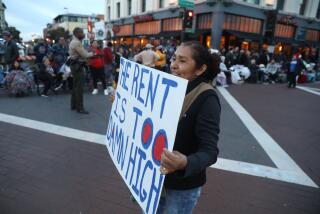U.S. wealth gap grew during recession, Stanford report finds

- Share via
Poorer Americans suffered bigger blows than richer ones as the housing market fizzled during the Great Recession, causing wealth inequality to surge for the first time since the 1980s, a new report finds.
During the recession, tumbling values in the housing market “increased wealth inequality because houses are the main asset of less advantaged groups,” reported the Stanford Center on Poverty and Inequality. Unlike the very rich, who held more of their wealth in stocks or businesses, poor and middle-class Americans banked more heavily on housing.
The growing gap in wealth is one of many signs of the widening divide between Americans of different races and means, according to the nonpartisan center. Though the rise in income inequality has already spurred protests and political debate in Washington, “wealth inequality” goes beyond income to include the value of assets such as homes.
The report found that the Gini coefficient for wealth -- a frequently used measure of inequality -- rose from 0.80 to 0.83 between 1983 and 1989, then stayed “virtually unchanged” for nearly two decades. After the downturn, however, the Gini coefficient for wealth rose to 0.87 by 2010.
Inequality also increased along racial lines, the center found: Black and Latino Americans suffered bigger blows to their net worth than white Americans. For instance, in 2007 the average net worth of Latino households was 26% that of white households; in 2010 it had fallen to 15%.
Noting previous studies, researchers also found that income inequality rose after the downturn ended, resuming its “nearly relentless growth … over the last 30 years.” But the new report also goes far beyond finances to examine how inequality has shaped American education, health and even lifespans:
--Though Americans are living longer, on average, there’s “a troubling trend toward growing income inequality in life expectancy,” researchers wrote.
In 1977, a 65-year-old man earning more than median earnings could expect to live another 15.5 years -- half a year longer, on average, than a man earning less than the median. By 2006, that gap had widened to 5.5 years. The bulk of recent gains in life expectancy have gone to Americans with higher-than-median earnings, the report found.
--Since the recession, Americans have been more likely to forgo medical care that they needed because of the cost. But blacks and Latinos had bigger increases in forgoing care than whites, widening the gap. (Rates for Asian Americans oscillated over the decade.)
The gap between the rich and poor who forgo care also grew, rising from 12.7 percentage points to 14.1 percentage points between 1997 and 2012, the report found.
All in all, “the results presented here reveal an economy that is failing to deliver the jobs, a failure that then generates much poverty, that exposes the safety net to demands well beyond its capacity to meet them, that produces too many children poorly prepared for school, and that places equally harsh demands on our healthcare, penal and retirement systems,” the center concluded.
It recommended that reformers focus on jobs rather than “piecemeal reform” to the institutions trying to grapple with its effects.
Twitter: @latimesemily
More to Read
Inside the business of entertainment
The Wide Shot brings you news, analysis and insights on everything from streaming wars to production — and what it all means for the future.
You may occasionally receive promotional content from the Los Angeles Times.











